Are you looking for a tattoo design that represents strength, power, and mystery? Look no further than the Angel of Death tattoo. This tattoo design has been around for centuries, and its meaning has evolved over time. In this article with Impeccable Nest, we will explore the history and meaning of the Angel of Death tattoo. We will also discuss some popular designs and offer advice on how to choose the right one for you.
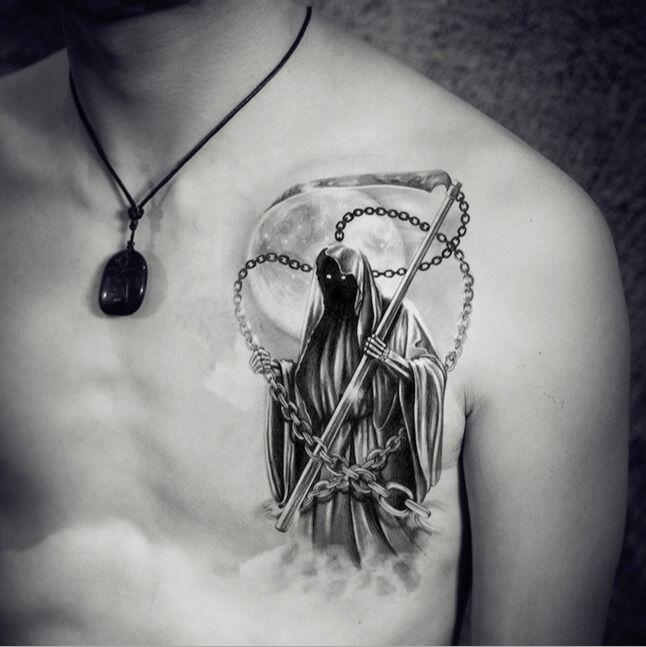
The History of the Angel of Death Tattoo
The Angel of Death has been a popular symbol in many cultures throughout history. In ancient Greek mythology, Thanatos was the personification of death. In Norse mythology, Hel was the goddess of death and ruled over the underworld. In Christianity, the Angel of Death is often associated with the Archangel Michael.
The Angel of Death has also been a popular subject in art and literature. For example, the famous poet William Butler Yeats wrote a poem called “Leda and the Swan,” which depicts the Angel of Death as a powerful, mysterious figure.
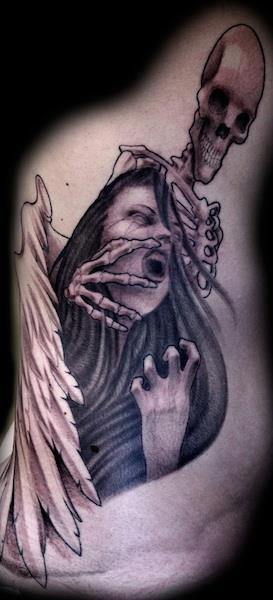
Angel of Death Tattoo Meaning: Unveiling the Secrets
The meaning of the Angel of Death tattoo can vary depending on the individual’s cultural background and personal beliefs. However, some common themes that are associated with this tattoo include:
Power and Strength
The Angel of Death tattoo design is a powerful and unique symbol that holds a deep meaning for those who choose to adorn it on their skin. It represents the embodiment of death, often depicted as a menacing figure with dark wings and a black cloak, carrying a scythe or sword. The image of the Angel of Death can inspire both fear and awe in equal measure, but for many people, this tattoo design has a more personal and significant meaning.
At its core, the Angel of Death tattoo design represents inner strength and resilience. It is a reminder that we must all face our mortality, but also a testament to our ability to persevere in the face of adversity. The image of the Angel of Death can be interpreted in many ways, depending on the individual’s perspective and life experiences.
For some, the Angel of Death tattoo design may represent acceptance of the inevitability of death. It can serve as a reminder that life is precious and fleeting, and that we must make the most of every moment. This interpretation can be especially profound for those who have experienced loss or are facing a terminal illness themselves.
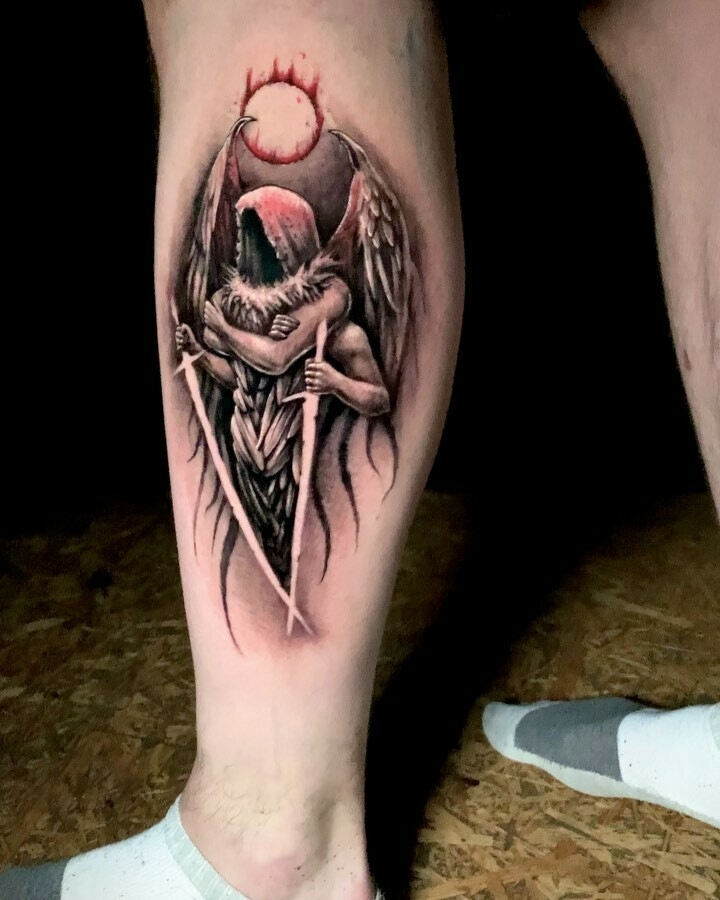
Others may see the Angel of Death tattoo design as a symbol of power and control. It can represent an acknowledgement of one’s own strength and ability to face challenges head-on. This interpretation may be particularly meaningful for someone who has overcome great obstacles or has a strong sense of determination and resilience.
Regardless of how someone chooses to interpret the Angel of Death tattoo design, there is no denying its striking aesthetic appeal. The image of a dark, otherworldly being is both eerie and beautiful, making it a popular choice for tattoos. It can be rendered in many different styles, from realistic portraits to stylized illustrations, making it a versatile design that can be customized to each individual’s taste.
In conclusion, the Angel of Death tattoo design holds a powerful and multifaceted meaning for those who choose to wear it. It can represent acceptance, resilience, and strength, or serve as a reminder of life’s preciousness. Regardless of the interpretation, this tattoo design is sure to make a bold statement and inspire both awe and admiration.
Mystery and Intrigue
The Angel of Death tattoo is a popular choice for those seeking to embrace the darker side of life. This tattoo design typically depicts a figure shrouded in dark robes, carrying either a scythe or a lantern. The symbolism behind this image can vary depending on the individual’s interpretation, but generally, it represents a fascination with the unknown and a desire for adventure.
One possible meaning behind the Angel of Death tattoo is a fascination with the idea of mortality and the afterlife. For many people, the concept of death is both frightening and intriguing. This tattoo design can serve as a reminder that death is an inevitable part of life, and that we should embrace every moment to the fullest.
Additionally, the Angel of Death tattoo can symbolize a desire for adventure and exploration. The figure depicted in this tattoo is often associated with mystery and the unknown, which can be interpreted as a call to explore new places and take risks in life. It can also represent a desire for change or transformation, as the Angel of Death is often associated with endings and new beginnings.
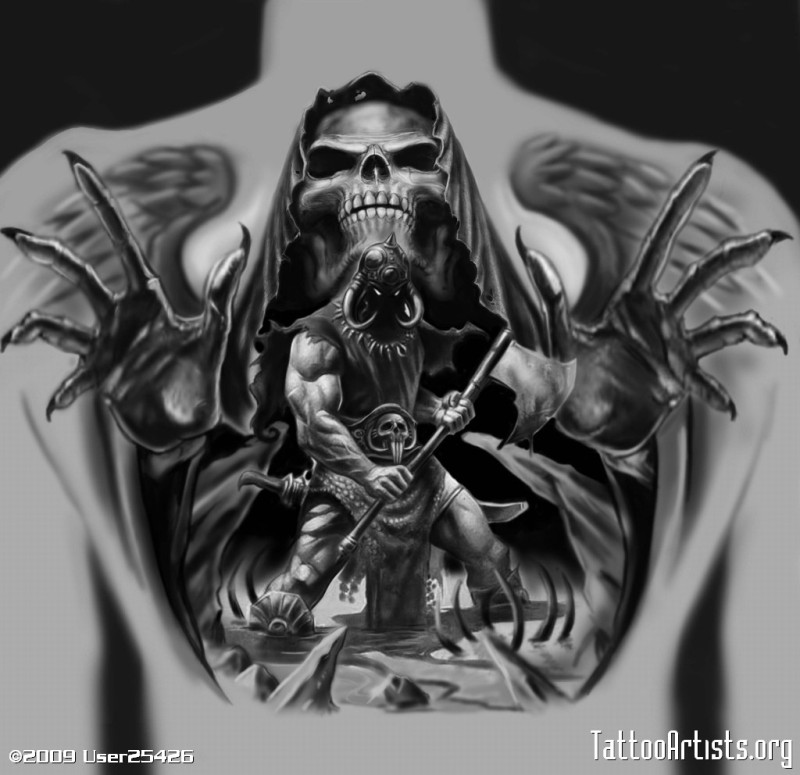
Of course, like any tattoo design, the Angel of Death tattoo can have different meanings for different people. Some may see it as a tribute to a loved one who has passed away, while others may simply appreciate the aesthetic appeal of the design. Ultimately, the significance of this tattoo will depend on the individual’s personal beliefs and experiences.
It’s worth noting that the Angel of Death tattoo is not intended to glorify death or encourage risky behavior. Rather, it is a symbol of the human experience and our own mortality. As with any tattoo design, it’s important to carefully consider the potential meanings and implications before getting inked. A skilled tattoo artist can help you create a design that reflects your personal beliefs and values, while also being visually striking and meaningful.
Mortality and Impermanence
The Angel of Death tattoo is one of the most profound and meaningful designs that a person can choose to adorn their body. It carries with it a rich history of beliefs, cultural traditions, and symbolism, making it a popular choice among those who want to convey a deeper message through their tattoos.
At the core of this design lies the concept of death, which has been an ever-present theme in human life for as long as we have existed. The Angel of Death, in particular, is a figure that has been depicted in various cultures and religions, often as a messenger or guide that accompanies and guides souls to the afterlife. This idea of a spiritual guide that helps people transition from one state of being to another is what makes the Angel of Death such a powerful symbol for those who choose to ink it onto their skin.
One of the key meanings of an Angel of Death tattoo is acceptance. By choosing to adorn their body with this design, individuals are acknowledging the inevitability of death and coming to terms with their own mortality. This can be a powerful way to confront existential fears and anxieties, reminding us that life is fleeting and that we should make the most of every moment we have.
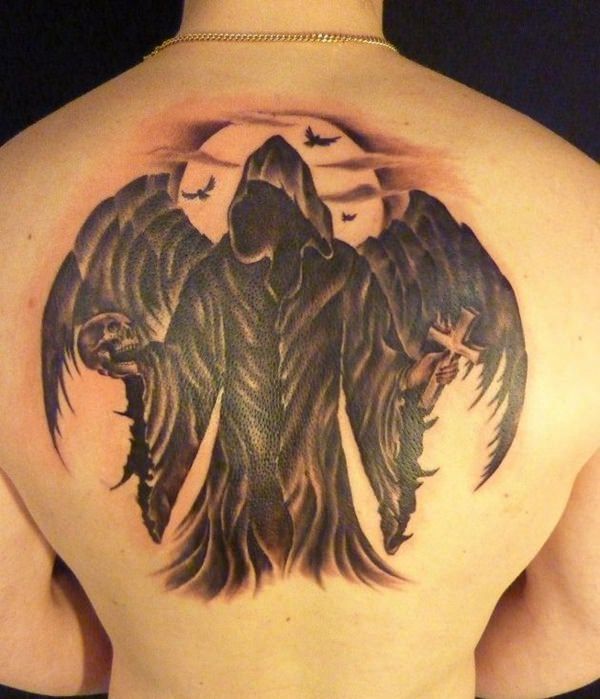
Another important aspect of the Angel of Death tattoo is impermanence. Just as the Angel of Death reminds us that life is finite, it also serves as a reminder that nothing in this world lasts forever. Whether it’s relationships, possessions, or even our own bodies, everything is subject to change and decay over time. This can be a humbling and grounding realization, helping us stay mindful of the present moment and appreciate the beauty of things while they last.
The Angel of Death tattoo can also evoke feelings of spirituality and mysticism. In many cultures, death is seen as a gateway to another realm of existence, and the Angel of Death is often associated with otherworldly powers and knowledge. For some, this tattoo design can be a way to connect with these deeper spiritual currents and tap into a sense of awe and wonder about the mysteries of life and death.
Of course, the meaning of an Angel of Death tattoo can vary depending on the individual and their personal beliefs and experiences. Some may choose this design as a tribute to loved ones who have passed away, while others may see it as a symbol of strength and resilience in the face of adversity. Whatever the reason for choosing this tattoo, it is clear that the Angel of Death is a powerful and multifaceted symbol that can convey a range of emotions and ideas.
Protection and Guidance
The Angel of Death, also known as the Grim Reaper, is a figure that represents the end of life. However, some people believe that this entity can also offer protection and guidance to those who seek it. As such, the Angel of Death tattoo has become a popular design for those who want to express their spiritual beliefs.
For many, the Angel of Death symbolizes the journey through life and the end of that journey. It reminds us that death is a natural part of life and that we should not fear it but instead embrace it as part of our existence. In this way, the Angel of Death tattoo can serve as a reminder to live life to the fullest and to appreciate every moment.
Additionally, some people believe that the Angel of Death can guide us on our journey through life. The tattoo can be seen as a symbol of spiritual protection, a way of asking for the Angel’s guidance in times of need. For those who believe in the afterlife, the Angel of Death tattoo can also serve as a symbol of hope, a reminder that death is not the end but rather a transition into a new form of existence.
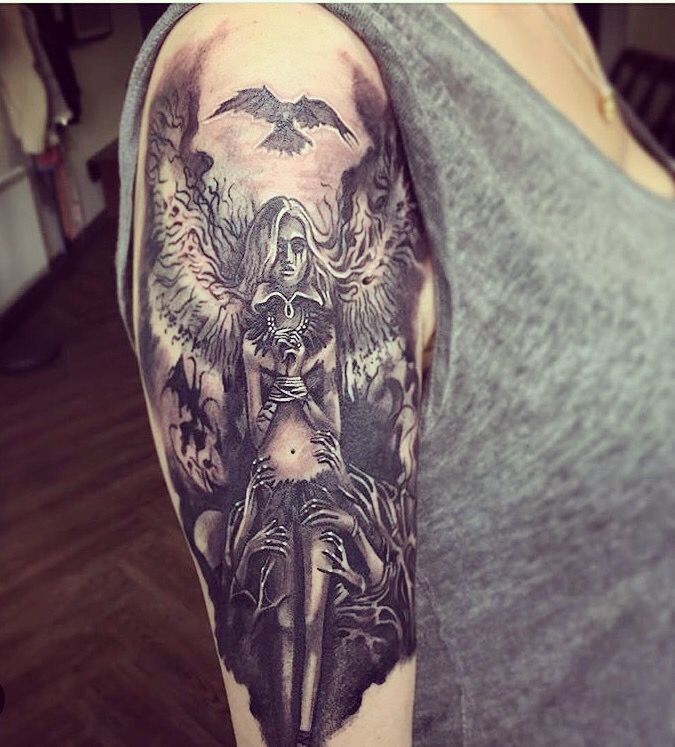
In terms of design, the Angel of Death tattoo can take many different forms. Some people opt for a more traditional design, with the Angel depicted as a skeletal figure wearing a hooded robe and carrying a scythe. Others may choose a more modern interpretation, with the Angel portrayed as a more ethereal or mystical figure. Whatever the design, the Angel of Death tattoo can be a powerful symbol of spirituality and personal belief.
Overall, the Angel of Death tattoo can hold a deep and personal meaning for those who choose to get it. Whether as a symbol of acceptance, guidance, or protection, this tattoo can serve as a reminder of the importance of spirituality and faith in our lives.
Darkness and Light
An angel of death tattoo is a powerful symbol that has been widely used in the world of body art and has various interpretations. At first glance, it may seem like an ominous design, but its meaning goes beyond what meets the eye. The angel of death represents an entity that oversees the final transition from life to death, indicating that everything will eventually come to an end. However, this figure also signifies transcendence and metamorphosis, allowing us to move from one phase to another.
The angel of death is often portrayed as a dark and mysterious being, associated with destruction and endings. This representation may be unsettling for some people, but it highlights the inevitability of death, a concept that we all have to deal with throughout our lives. Despite its association with darkness, the angel of death is also a guide between realms, signifying that there is something more significant beyond the physical world. It represents enlightenment, wisdom, and spiritual liberation, as well as the possibility of eternal life.

An angel of death tattoo can be interpreted in different ways, depending on the individual’s beliefs and experiences. Some people may view it as a reminder of their mortality, while others may see it as a symbol of transformation or rebirth. For instance, someone who has gone through a traumatic experience and emerged stronger may choose this tattoo as a way to commemorate their journey. Alternatively, someone who is going through a difficult phase in their life may choose an angel of death tattoo as a source of inspiration, reminding them that they can overcome their struggles and emerge victorious.
An angel of death tattoo combines both dark and light elements, balancing out the negative connotations with positive ones. It is a symbol of duality, representing the interconnection between life and death, light and darkness, birth, and rebirth. This tattoo is not for everyone, and it requires careful consideration before getting inked. It is imperative to understand the symbolism behind the design and the implications that come with it. However, for those who resonate with the meaning of an angel of death tattoo, it can be a powerful symbol of their spiritual journey and personal growth.
Different Angel of Death Tattoo Designs
Angel of Death tattoos are versatile, and there are various designs to choose from. Here are some of the most popular ones:
Grim Reaper
The Grim Reaper is one of the most common designs for an angel of death tattoo. The Grim Reaper is usually shown in a long black robe, carrying a scythe, and sometimes accompanied by a flock of crows. This design is popular because it is easy to recognize and can be customized according to the wearer’s preference.
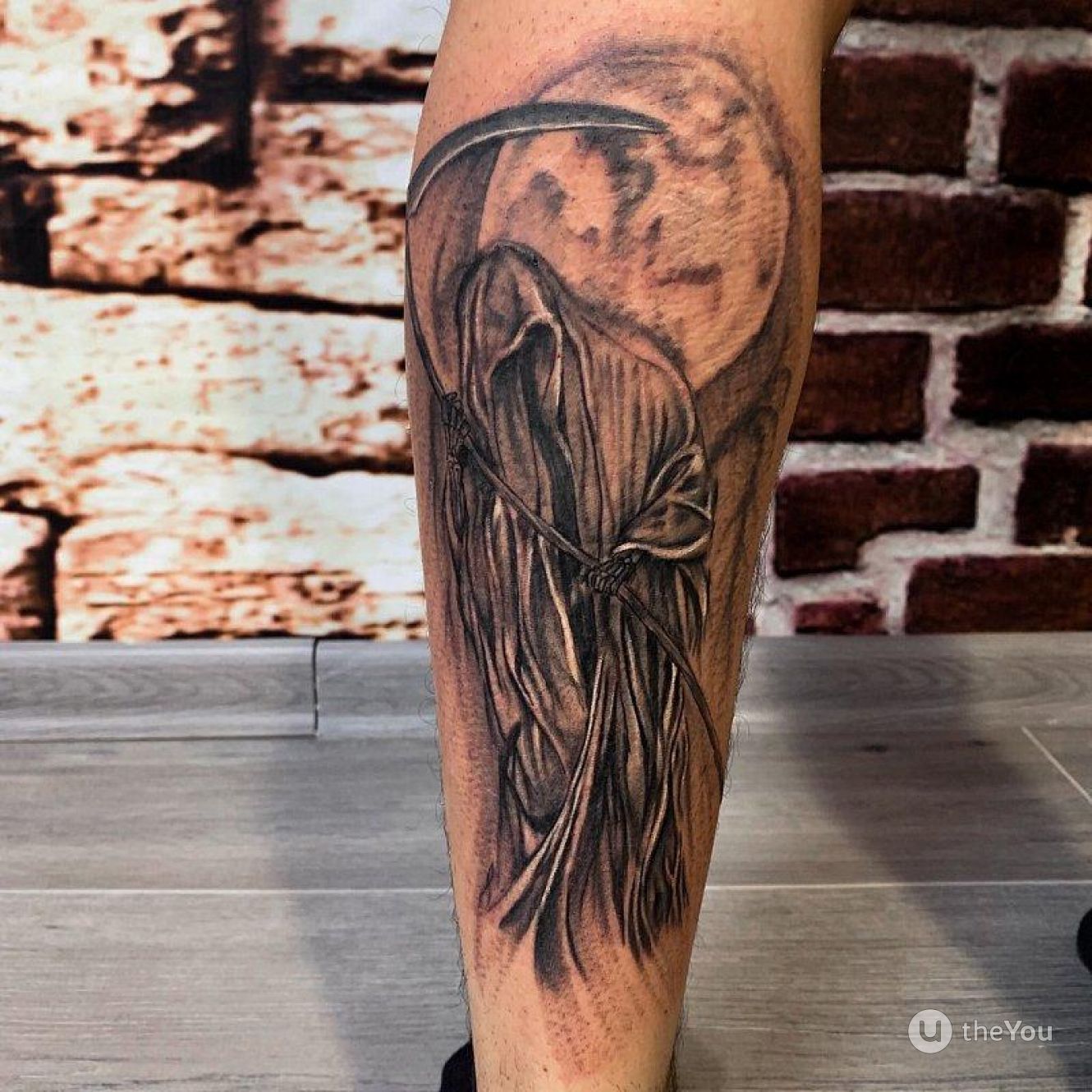
Demon
A demon is another popular design for an angel of death tattoo. Demons are often associated with the underworld, and they have been used in various cultures to represent evil spirits. This design is popular because it allows the wearer to combine the concept of the angel of death with a darker and more sinister image.
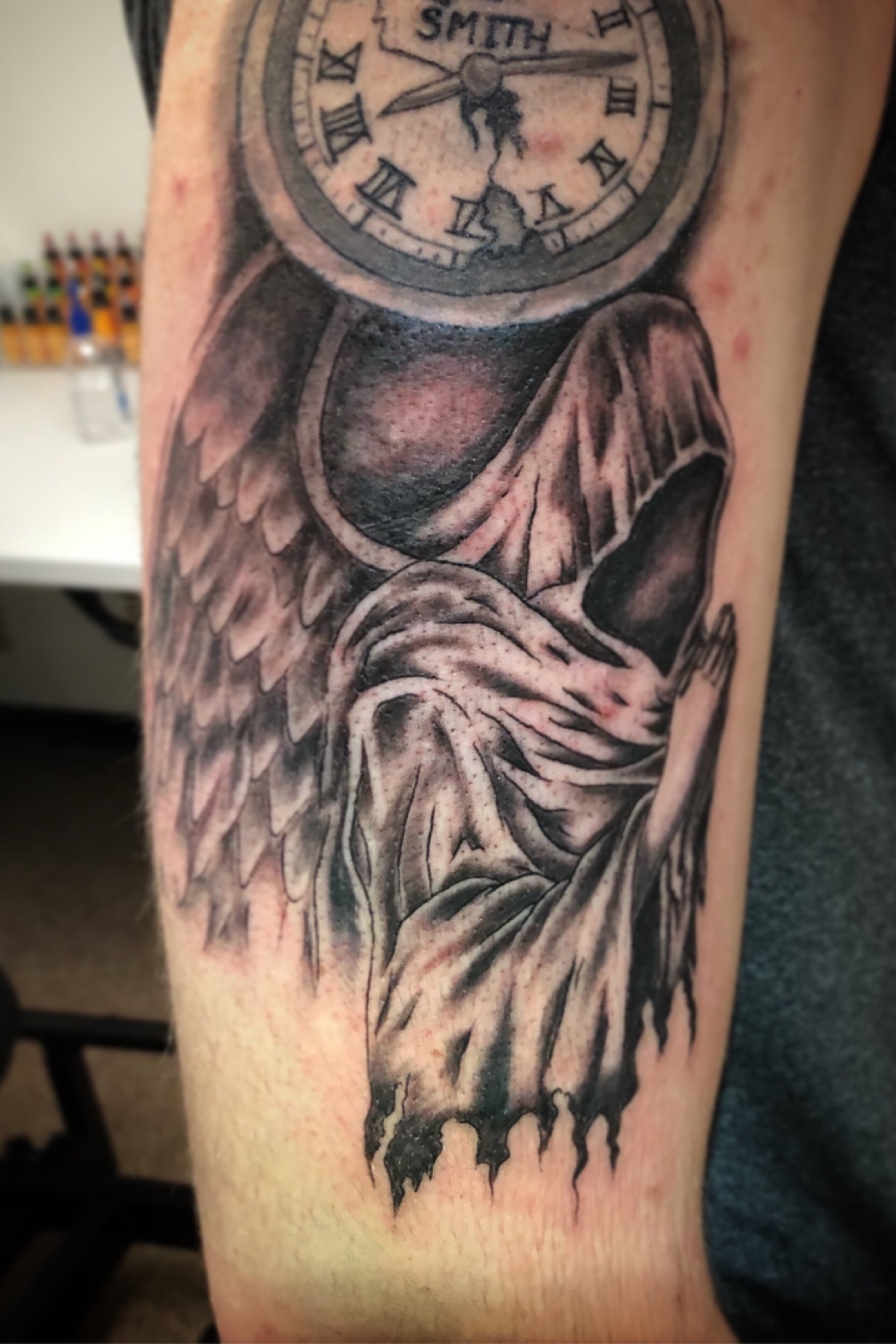
Dark Angel
The dark angel is a popular tattoo design because it combines the angel of death with an angelic figure. This design can be customized in various ways and can represent the duality of good and evil. The dark angel design typically has a somber and mysterious appearance, with black wings and a mournful expression.

How to Choose the Right Angel of Death Tattoo Design
Choosing the right Angel of Death tattoo design is a personal decision. To find the perfect design for you, consider the following factors:
Personal Meaning
Think about what the Angel of Death represents to you personally. Do you connect with the themes of power, strength, and resilience? Or do you resonate more with the themes of mystery and intrigue?
Artistic Style
Consider the artistic style that you prefer. Do you like realistic portraits, or are you drawn to more abstract designs?
Placement
Think about where you want to place your tattoo. Consider how visible you want it to be and whether you want it to be easily concealable.
Size
Finally, decide on the size of your tattoo. Do you want a small, subtle design, or are you looking for a larger, more dramatic piece?
Conclusion
The Angel of Death tattoo is a powerful and mysterious design that has been around for centuries. Whether you are drawn to its symbolism of power and strength or its representation of mortality and impermanence, there is a design out there that will suit your personal style and beliefs. By understanding the history and symbolism behind this tattoo, you can make an informed decision about whether it is the right choice for you.
Remember to take into account factors like personal meaning, artistic style, placement, and size when choosing your Angel of Death tattoo design. And always work with a reputable tattoo artist who takes the time to listen to your needs and create a design that is unique and meaningful to you.
In the end, the Angel of Death tattoo is a powerful statement about life, death, and the unknown. Whether you choose a Grim Reaper or Dark Angel design, or something more abstract, this tattoo can be a reminder of your inner strength and resilience in the face of life’s challenges.

I am Harvey Berry, a tattoo enthusiast who has immersed himself in the diverse world of ink, passionately exploring the beauty and artistry within each tattoo. My mission extends beyond uncovering the aesthetics of tattooing; it involves sharing in-depth knowledge across all aspects of this art form.
Fueled by genuine curiosity and love for every facet of tattooing, I have diligently crafted well-researched articles, with a special focus on the Tattoo Meaning of Impeccable Nest section. Here, my aim is to help the tattoo community gain a deeper understanding of the meanings and values embedded in each tattoo.
One of my primary goals is to encourage responsible decision-making when it comes to getting inked. I recognize that choosing to get a tattoo is a significant personal decision that requires careful consideration. Hence, I provide diverse resources covering the meaning of tattoos, the tattooing process, aftercare tips, and other valuable information.
Whether you are a seasoned tattoo enthusiast or embarking on your first exploration of the world of body art, I aspire to be a reliable resource for you at every step of your journey. I hope that my extensive knowledge of tattoos, especially in the Tattoo Meaning section, will assist you in finding inspiration to express yourself through the art of tattoos.
